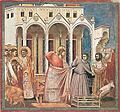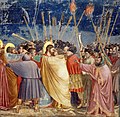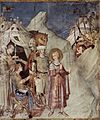Painting in the Gothic
The Gothic painting developed from the 12th century to the 16th century. In its early and middle phase it was entirely meaning painting, in which mostly the focus was not on the naturalistic representation of people or the spatial perspective, but on the arrangement, proportioning and coloring according to religious meaning (" meaning perspective "). In the choice of motifs, the religious dominated ( winged altars , devotional pictures, etc.), but secular motifs such as court life, hunting and celebrations were also taken up.
Different techniques and regions
Favored by the emergence of large window areas, stained glass replaced the fresco north of the Alps at the beginning of the Gothic period and flourished.
Here, however, Italy took a special position because the architecture there received large wall surfaces. The climax of the Gothic frescoes was certainly Giotto di Bondone with his unprecedented naturalism . He enlivened his room with depth and responded to each of his characters individually in facial expressions and gestures.
In addition to glass painting , book illumination also flourished in France from the middle of the 13th century , with which not only liturgical works, but also books of hours and secular manuscripts were increasingly equipped. The peak of this development was formed by the Limburg brothers and their masterpiece, the Très Riches Heures du Duc de Berry (1413–1416). For a long time, book illumination remained the predominant form of painting. B. until the beginning of the 15th century, and thus had a great influence on the development of panel painting .
Here, too, Italy took on a special role, since panel painting had a priority there from the beginning of the Gothic period. Cimabue was the first to take steps on the path of naturalism . Although his works remained very Byzantine , they already gained their first depth. He was followed by Duccio , whose painting, with its flowing lines, loosely falling robes and already increased depth, shows the new style, but has not yet broken away from the old.
Giotto di Bondone succeeded in doing this . He endeavored to bring all elements of a picture together into a coherent unit, which meant a significant advance in painting. It was so outstanding that although it clearly belongs to the Gothic period, it is often mentioned as a guide to the Renaissance .
The Gothic in its purest style was embodied in Italy by Simone Martini with his courtly elegance. Since the second half of the 14th century, panel painting took a priority over book illumination north of the Alps, not least because of Martini, but also because of the well-traveled Gentile da Fabriano and Pisanellos . Art centers were formed in Bohemia and at the papal court in Avignon . Martini was also appointed there in 1340/41, which further expanded his sphere of influence.
Through the synthesis of Martini's courtly elegance and the Flemish striving for attention to detail as well as the inclusion of Italian and French influences, an international style , also known as the beautiful or soft style , was created in the second half of the 14th century . In contrast to the currents that previously existed side by side, this was pan-European . Important schools arose at the courts in Paris, Milan and Bohemia, where Emperor Charles IV promoted the new art.
The International Gothic prefers soft facial features, a curved posture of the depicted persons (S-curve) and a flowing, soft, lush depiction of the folds.
The Wilton Diptych is a good example of how international this style really was . The fact that it came into being at the end of the reign of Richard II of England at the hands of a Flemish, English, French or Bohemian are the only characteristics that art historians have been able to identify with him so far.
The development separated around 1420. The early Renaissance began in Italy, and in the north the Flemish primitives appeared, who opposed courtly elegance with bourgeois simplicity. The gold ground finally gave way. Instead, the representation of the landscape was perfected, the bluing developed, and scenes in interiors were increasingly being created. They managed to show a coherent perspective, although this was not constructed as in Italy. A co-founder of this new direction was Robert Campin . Jan van Eyck established oil paint by using a new binding agent. Oil paints have the advantage over tempera paints that they retain their shine longer. One of Campin's students, Rogier van der Weyden , portrayed people in a new psychological intensity and perfected the rendering of materiality. He also combined the naturalism of the Flemish with the formal language of the Gothic. Hieronymus Bosch contrasted the naturalness of the other with a bizarre, terrifying world full of apocalyptic mood and remained more strongly attached to the late Gothic.
In the late Gothic period , there was widespread apocalyptic sentiment, as it was believed that the world could end in 1500. It was a time of upheaval in which the passion of Christ was dealt with more and more and it was presented more and more drastically. On the other hand, the influence of the Renaissance grew stronger. One of the last great Gothic painters was Matthias Grünewald , who can be seen as Dürer's intellectual antipode. His depictions of the crucifixion are among the most drastic, the Isenheim Altarpiece is considered his masterpiece. After this time (around 1525/30) the Renaissance finally prevailed. Only in England did the Gothic remain for some time in painting as well as in architecture; an example are the portraits of Elizabeth I.
Frescoes
The painting of Runkelstein Castle near Bozen , which was commissioned by Niklaus Vintler between 1390 and 1410 and shows courtly scenes alongside literary material, is considered to be the largest secular fresco collection of the Middle Ages .
Maesta of Cimabue ,
around 1280, San Francesco, AssisiJesus drives out the merchants from Giotto , 1305,
Scrovegni Chapel, PaduaKiss of Judas
by Giotto , 1304–1306, Scrovegni Chapel, PaduaSt. Martin turns away from life as a knight
by Simone Martini , 1317–1319, San Francesco, Assisi
Panel painting
Annunciation ,
Simone Martini , 1333Creation of the Animals , Petri Altar, Master Bertram , around 1380, Hamburg, Kunsthalle
The Columba or Three Kings altar by Rogier van der Weyden , approx. 1455, Alte Pinakothek, Munich (originally St. Columba, Cologne)
Madonna im Rosenhag by Stefan Lochner , around 1448, painting on wood, Wallraf-Richartz-Museum, Cologne
Garden of Earthly Delights
by Hieronymus Bosch , 1515, oil on panel, Prado, MadridFirst face of the Isenheim Altarpiece , Matthias Grünewald , 1506–1515, Colmar, Musée d'Unterlinden
Book illumination
In France and England the Gothic began in book illumination around 1160/70, while in Germany Romanesque forms remained dominant until around 1300. Throughout the entire Gothic epoch, France, as the leading art nation, was decisive for the stylistic developments in book illumination. At the same time as the transition from the late Gothic to the Renaissance, book illumination lost its role as one of the most important art genres due to the spread of book printing in the second half of the 15th century.
At the turn of the 12th to the 13th century, commercial book production took on the side of monastic book production. The universities were the starting point for this serious turning point ; for the illumination, however, the high nobility was more important, which came a little later as a client of secular courtly literature . The most illustrated type of book was the book of hours intended for private use . With the development of commercial studios, more and more artistic personalities appeared in the Gothic era. From the 14th century onwards, the master who ran a workshop with which he was active in both panel and book painting became typical .
Stylistic characteristics that remained valid throughout the Gothic period were a soft, sweeping figure style with a supple, curvy, linear ductus, courtly elegance, elongated figures and flowing folds. Further characteristics were the use of contemporary architectural elements for the decorative arrangement of the picture fields. From the second half of the 12th century in Europe mostly red and blue found Fleuronné initials as a decoration typical form of manuscripts of the lower and middle levels of equipment use. Independent scenes as historicized initials and drolleries at the lower edge of the picture offered space for imaginative depictions independent of the illustrated text and contributed significantly to the individualization of the painting and to turning away from frozen picture formulas. A naturalistic realism with perspective, spatial depth effects, light effects and realistic anatomy of the persons depicted, based on the realism of the art of the southern Netherlands , increasingly prevailed in the course of the 15th century and pointed to the Renaissance.
January from Très Riches Heures du duc de Berry , Brothers Limbourg , 1412–1416, Chantilly, Musée Condé
The Evangelist Luke , Très Riches Heures du duc de Berry , Limbourg Brothers , 1412–1416, Chantilly, Musée Condé
Birth of John the Baptist , Très Belles Heures de Notre-Dame , Master G of the Milanese Prayer Book (possibly Jan van Eyck ), 1422, Milan
Stained glass
→ Main article: Stained glass (sacred windows)
Individual evidence
- ^ Article Perspective in: The great Brockhaus in twelve volumes , 18th edition, Volume 8, Wiesbaden 1979
- ↑ http://www.runkelstein.info/runkelstein_de/geschichte.asp
literature
- Arno Borst : Life forms of the Middle Ages . Frankfurt / Berlin / Vienna 1979. (contains, among other things, a German translation of the famous “Gervasius” report).
- Claus Bernet : "Gotik", Norderstedt 2014, ISBN 978-3-7347-8641-9 .
- Georges Duby : The time of the cathedrals. Art and Society 980-1420 [1976]. Frankfurt am Main [1992] 2nd edition 1994.
- Géza Entz: The Art of Gothic . Emil Vollmer, Munich 1981, ISBN 3-87876-340-9 .
- Michael Camille: The Art of Gothic . 1996.
- Florens Deuchler : Gothic. Herrsching: Pawlak, 1981 ( Bels style history ), ISBN 3-88199-042-9 .
- Alain Erlande-Brandenburg : Gothic Art . Herder, Freiburg-Basel-Vienna 1984.
- Emile Mâle : L'Art religieux du XIIIe siècle en France . Paris 1899.
- Emile Mâle: L'Art allemand et l'art français du Moyen Âge . Paris 1917.
- Matthias Puhle (ed.): Departure into the Gothic , Philipp von Zabern, Mainz 2009, ISBN 3-8053-4062-1 .
- Rolf Toman , Achim Bednorz: Gothic. Architecture - sculpture - painting. Könemann im Tandem-Verlag, 2005, ISBN 3-8331-1038-4 .
See also
- Gothic
- Gothic book illumination • Main works of Gothic book illumination
- Panel painting (painting)
- Gothic sculpture • Fine arts • Ornament















